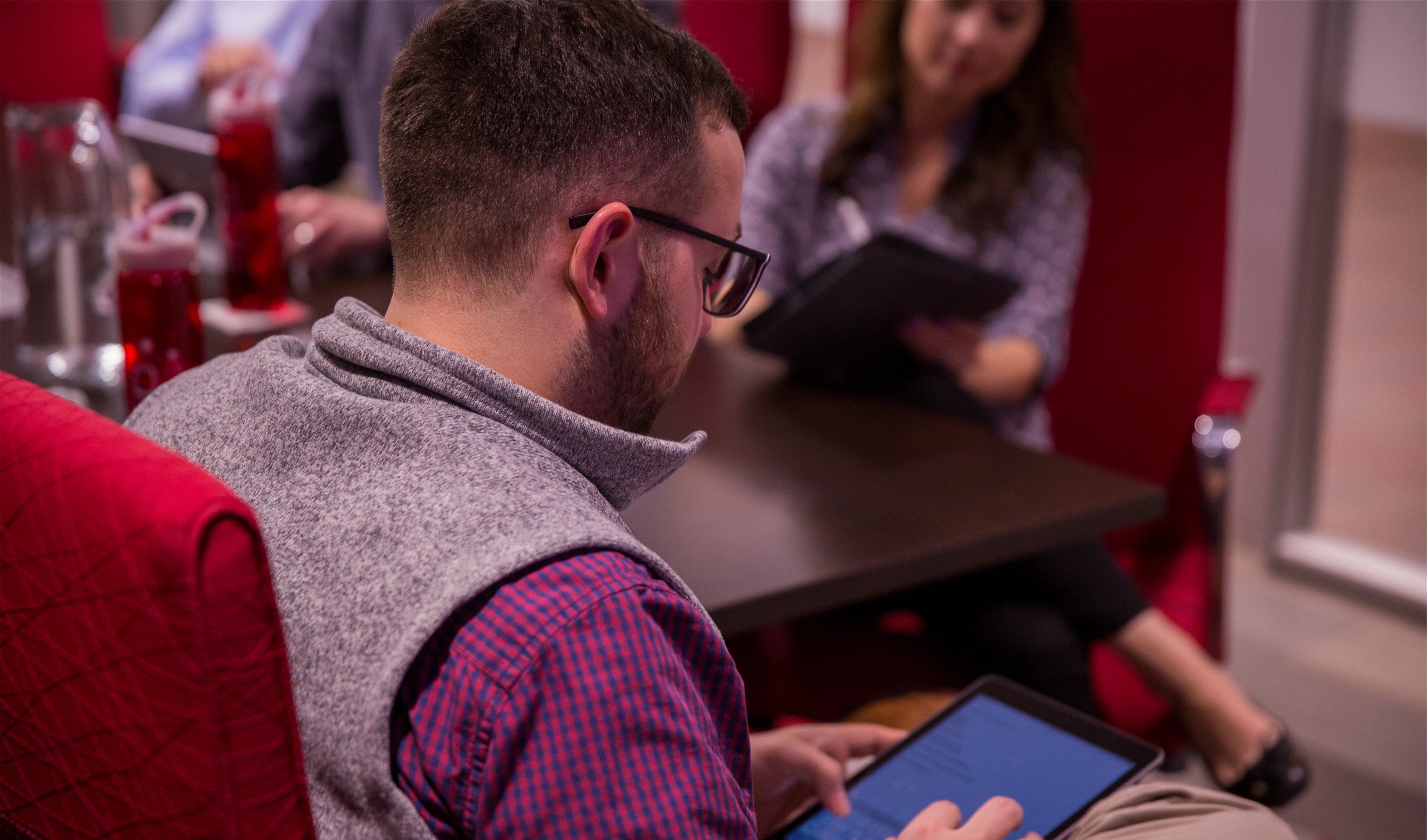IT Year in Review 2022
The Office of Technology and Digital Innovation (OTDI) is passionate about problem solving and customer service, striving to become a digitally optimized organization for all Ohio State technology clients.
This year OTDI went from being two distinct entities – the Office of the Chief Information Officer and the Office of Distance Education and eLearning – to our new singular identity, the Office of Technology and Digital Innovation, which better reflects how the entire team works together operationally. Like most colleges and business units, we have evolved into the strong unit we are today. Learn more throughout the next few months through our History of OTDI video series. For our most recent accomplishments, this page -- our Year in Review -- summarizes all we have accomplished together in 2022. These successes were only possible because OTDI teams worked in collaboration with countless colleges, business units and stakeholders across the university.
Strive to Become a Digitally Transformed Organization
Modernize infrastructure to support the future of higher education
Growing Tableau Usage
Tableau is another growing data services tools, with contract-tracing and other usage to support Ohio State’s COVID-19 response exemplifying just how much Tableau adoption rates have grown over the last three years. Our three years of Tableau blog series, illustrates how Ohio State's adoption of Tableau in late 2018 helped usher in a new level of data accuracy and transparency while encouraging collaboration at all levels of the university and beyond. To ensure our users get the most out of Tableau, this year we hosted Tableau Server Fundamentals, a live, 45-minute zoom webinar for anyone who accesses Tableau reports on the university’s server.
Building Student Digital Skills
This year we launched virtual desktop, which enables students to access key applications from anywhere. This year, we also facilitated the launch of student access to Adobe Creative Cloud, giving students free access to an entire suite of digital creation tools to support learning and build their skills for future careers. We also launch the Digital Skill Competencies, a significant cross-institutional collaboration of institutional leaders, faculty, students, and employers to arrive at a set of competencies that allow us to intentionally build up learner digital skills for career readiness, advancement, and success. Finally, OTDI was proud to enable Ohio 4-H via Ohio State Extension to bring coding learning opportunities to K12 students and teachers across the state and in Columbus City Schools for the next two years using our Mobile Design Lab, in alignment with STEAMM Rising. STEAMM Rising Columbus is a new initiative to collectively develop STEAMM talent in Columbus and ensure that talent thrives in the university’s Innovation District and elsewhere. STEAMM stands for science, technology, engineering, arts, mathematics and medicine.
Reimagining Our Leadership Team
We have also welcomed a few new senior leaders, some from within the university and some from outside of it. This year Rob Griffiths expanded his responsibilities in our organization and took on the role of Chief Digital Learning Officer. In early fall Ginger Breon from the College of Engineering was appointed Chief Technology Officer. From outside of the university, we also welcomed Lynne Sanbe as Chief Applications Officer and CK Bhatia as Chief Data Integrations Officer.
Implementing Systems that are Secure by Design
We are committed to implementing systems that address cybersecurity, privacy, and accessibility standards. To that end, we continue to collaborate with IT teams across the university to enhance the IT experience at Ohio State, including designing and building Shared Directory and Endpoint Services and preparing for rollout next year.


Expand Educational Opportunities
Creating more opportunity and access to educational resources
Teaching And Learning Tools for Instructors
Carmen is the centerpiece of our learning technology tools, as it links instructors and students to the information, they need to manage their courses. In addition to enhancements to Carmen quizzes this year, we assisted instructors in adding media to textbooks, began work to build a new Media Platform and introduced PebblePad to enable instructors to showcase their work in an ePortfolio.
Providing Affordable Learning for Students
For a seven years, the Affordable Learning Exchange has benefitted students with more economical resources. ALX represents a partnership that enables instructors to use technology to offer more cost-effective materials for their students. From the long-running CarmenBooks initiative to newer initiatives like the College of Art’s lending library, ALX furthers many of the values that comprise the university’s foundation.ent
Diversifying and Improving Learning Spaces
Continual improvement is a hallmark of the classrooms OTDI supports. We maintain a wealth of online resources to links both instructors and students to the resources that will enable them to be successful on their academic journey. From improving technology-enabled classrooms to adding new resources to Digital Unions, we remain committed to meeting the needs of Buckeyes regardless of their role at Ohio State.
Reaching More Students with Distance Learning
During the pandemic, Ohio State Online enrollment numbers skyrocketed bringing all-hands-on-deck to meet the rapid growth in demand. This year, enrollment is back to normal levels, but our commitment to quality is unwavering. Our online Nursing Master's Program Ranked No. 1 in the nation this year. Making classes work for specific is a competitive edge, which we capitalized on with changes to professional licensure and reciprocity, a smoother enrollment process for JP Morgan Chase analytics students and real-world problem solving for engineering students. In partnership with JobsOhio continued to to provide key support for academic pathways to in-demand careers. This included convening partners for design thinking sessions and connecting distance education and non-credit credentials to desired outcomes.
Integrating Technology into General Education
In a true cross-team collaboration, staff from OTDI was deeply involved int the successful implementation of the General Education Launch Seminar and design phase of the GE Reflection seminar. After collaboration with an interdisciplinary team of partners from across the university, Launch was designed using the OTDI Hybrid course quality best practices, built in a high-quality Carmen space to be shared across hundreds of concurrent sections, and provided our highest level of accessibility support, including the design, implementation, and student/faculty support for our new ePortfolio tool (PebblePad). To date, our involvement with Launch has included training of over 200 instructors on 6 campuses, with almost 3000 students having completed the course, and over 6,000 more registered for SP23. Reflection Seminar is designed as a fully online, synchronous course in alignment with Launch with the same high standards for course quality, accessibility, and student/faculty support and has been submitted for approval in early 2023.
Simplify Access to Research Technology
Reduce IT complexity for the Ohio State research community
Securing AWS Health Data
In an effort to keep both Research Health Information (RHI) and Protected Health Information (PHI) secured, the university has signed a Business Associate Agreement (BAA) with Amazon to enable researchers at the university to use Ohio State AWS (Amazon Web Services) work with S4 data (PHI and RHI). We also added Amazon Redshift to our offerings, a new server cluster that enables researchers to expand their data store to as much as 64 terabytes of data, with the same or better query performance and operational cost savings. As AWS has become increasingly popular, we hosted Campus Invent! to give researchers the opportunity to learn how AWS can help modernize their research.
Expanding Data Services
As technology options for research grows, our Data Services team launched it.osu.edu/data as a starting point for learning more about the Data Services toolset, including Tableau, Reporting and Analytics Environment/Data Lake, Data Catalog, Data Governance, and more. We also published a new dashboard to help data analysts better understand which datasets they have access to within the Reporting and Analytics Environment (RAE). To help researchers keep data safe, we also updated Cloud Assessment Registry so it can be accessed as a Tableau table with real-time updates, rather than a static table.
Building a Tech Plan for the Interdisciplinary Research Facility
OTDI is heavily involved with the Interdisciplinary Research Facility, an exciting new addition to the Carmentown complex that will serve multiple research disciplines, including biomedical, life sciences, engineering and environmental sciences and the new Pelotonia Institute for Immuno-Oncology. These important research areas need stellar technology infrastructure to move forward, and we have more than 100 OTDI staff members at the university are working on this important new facility to ensure it is up-and-running by our May 2023 opening.
Using MS Azure for RHI Data
Researchers utilizing Research Health Information (RHI) in their work can now use Microsoft Azure to store the data and ensure it is kept securely. Ohio State does not permit the use or storage of Protected Health Information (PHI) in Azure. Microsoft Azure is a private and public cloud platform that provides a set of services that allow you to build, manage and deploy applications on a massive, global network using your favorite tools and frameworks. Applications may include any program or piece of software designed and written to fulfill a particular purpose for the user.


Inclusive Excellence and Engagement
Cultivate belonging in OTDI and give Ohio State community a stronger voice in our work
Making Campus More Accessible
Ohio State has accessible entrances for its buildings but finding and remembering exactly where they are on a large campus with numerous buildings can be daunting. To make this less challenging, the Ohio State App team added a new feature that map out the location of accessible entrances and wellness spaces, along with photos to make it easier to find these resources.
Recognizing Privacy Issues that Accompany Student Analytics
We use student analytics to inform decisions, but students are individuals and cannot be wholly defined by the information collected about them. The context in which analytics are used were an important focus for Privacy@Ohio State this year and one of our areas of focus during Data Privacy Month. The privacy program considers how we can use analytics while respecting privacy and works to balance the powerful potential for benefits with the possibility of harmful unintended consequences.
Expanding Knowledge Through Program 60
Because Ohio State believes you are never too old to stop learning, we offer Program 60 to Ohio residents age 60 and older. It gives older students the opportunity to experience academic excellence at Ohio State by enabling them to take noncredit and non-degree program courses, tuition-free. We don’t require participants to be alumni, but we met an alumnus this year who told us his story and how he used Program 60 to keep his mind sharp.
Creating More Inclusive Courses
Accomplishing new, innovative tools can take extra effort and money, so this year the Affordable Learning Exchange (ALX) grant program to enable instructors to infuse their courses with racial justice. Grant winners were primarily focused on reducing the cost of their course materials for students—from replacing textbooks to creating lending libraries of supplies.
Expand Shared Services & Continuous Improvement
Ensure our systems and services support the needs of the university community
Improving Dual-Factor Authentication
It’s been nearly a decade since Ohio State became a front-runner in offering dual authentication to protect our users and systems. As cybercrime becomes increasingly sophisticated, many businesses have followed suit, so we have all become familiar with this security measure in countless areas of our online life. This year we added BuckeyePass to our Sponsored Guest Process. In addition, Duo Mobile, the engine behind our dual authentication tool, upgraded its user interface
Expanding Our Microsoft Partnership
In 2021 we began a long journey to make OneDrive for Business and Teams our primary storage and collaboration tools, sunsetting our BuckeyeBox service. Since that time, we have added applications to the Microsoft 365 suite, offered training opportunities with the MS Learning Experience Portal and fine-tuned our MS Teams access review process.
Improving Our Wi-Fi Network
With more than 20,000 APs, Ohio State’s Wi-Fi infrastructure is like its own city, and just like any city, our digital “roads” and “sidewalks” need consistent updates. The network is so widely used, that our stats for most concurrent client devices and most data consumed through stadium Wi-Fi has exceeded that of any other sporting event on record - including the Super Bowl! This year, we made a big step forward in improving Wi-Fi at Ohio State by beginning the process of moving to device-based authentication and eduroam while continuing to encourage Wi-Fi users to take advantage of Registered4OSU, a network specifically for devices like printers, gaming and Apple TV.
Informing Buckeyes Of Security Risks
It is essential to continually educate users to protect themselves as the cyber-threat landscape continually expands. Our ground-breaking Cybersecurity for You platform celebrated its third year, and was featured in the Chronicle of Higher Education. In addition to C4U, we educate users throughout the year by requiring Institutional Data Policy Training, basic safety lessons for email and identity management and reminding them to put appropriate controls in place for applications like Microsoft 365 Teams and Groups. We also provide timely reminders at specific points during the year like tax season and send specific alerts when there is a phishing scheme or other threats that are currently threatening users. During Cybersecurity Awareness Month in October, we continue to host Cybersecurity Days annually, with offerings for users of varying skill levels.

